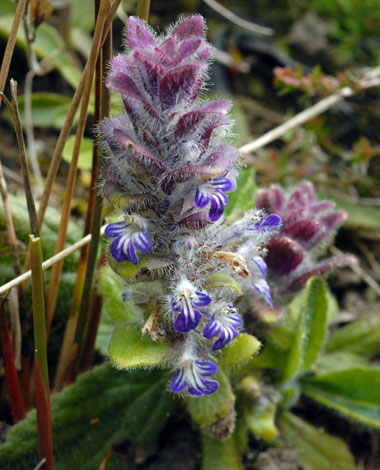Ajuga pyramidalis Pyramidal Bugle RR DDD N

In 2006 we found this plant in June but it was clear that the flowering period was much earlier probably the beginning of May hence this expedition to find the plant in flower. Ajuga pyramidalis is perhaps a little more pyramidal than the distinctly cylindrical Ajuga reptans but that isn't its most obvious feature. The characteristic which strikes you, particularly when viewing the plant through hand lens, is that the hairs are very dense and some are three times as long as the diameter of the stem. They tangle too and the term used by Stace to describe Senecio vernalis comes to mind: arachnoid.
No wild flower book I have seen refers to the delightful blue striped flowers. Cynically I wonder if authors of such flora ever bothered to travel so far north to see the plant for themselves or simply copied descriptions from other people.
The official discriminatory features are that the stem is hairy all round rather than hairy on two sides in A. reptans but this is much more difficult to discern than you might imagine. The inflorescence together with leafy bracts crowd the stem to such an extent that you can't see the stem very easily. The bracts are also supposed to be shorter than the florets in A. reptans which conveniently grows nearby. There are rhizomes (underground stems) in A. pyramidalis rather then the very obvious stolons (above ground) in A. reptans.
This is a plant of the Highlands and islands with just a few sites elsewhere. The greatest number are to be found north of Inverness but there are a few sites in the west of Ireland and one in the Lake District.
The site for this plant is on a lump (The Mound) of what looks like conglomerate rock which in the wet could be a bit treacherous.



